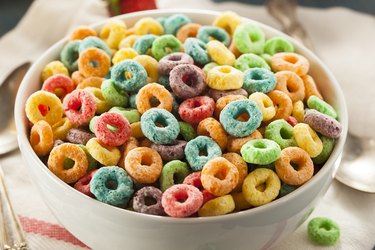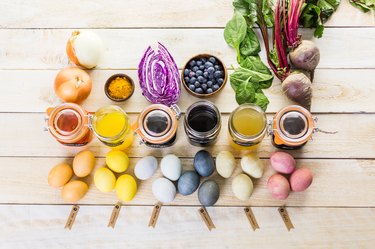
When bright shades of blue, red, green, yellow and purple turn cakes, doughnuts and candies into works of art, it's hard to resist them. But behind these foods' colorful appeal lies a darker side.
Throughout the past decade, there has been a growing concern over the potential health risks that come with consuming artificial food dyes.
Unlike natural food dyes — which are made from vegetables, fruits and spices — artificial (aka synthetic) color additives are derived from petroleum and are refined and tested until they no longer contain traces of petroleum, according to the American Chemical Society.
What Are the Artificial Color Dyes Used in Food?
Color additives are added to foods for a variety of reasons, including to offset color loss due to light, air and temperature exposures, and to correct and enhance natural colors, according to the Food and Drug Administration (FDA).
The FDA ensures that the color additives we see in foods have been put through a rigorous certification process for safety approval, and there are two types.
Two Different Types of Artificial Color Additives
- Dyes: Dyes come in powders, granules and liquids and easily dissolve in water. These dyes are often found in baked goods, drinks and dairy products.
- Lakes: Lakes are water-insoluble forms of dyes. Lakes are ideal for tainting foods that tend to be high in fats and oils. Candies, gum, supplements and some cake mixes use lakes instead of dyes.
Here are the nine certified synthetic color additives approved for use to look for in ingredient labels:
- FD&C Blue No. 1
- FD&C Blue No. 2
- FD&C Green No. 3
- FD&C Red No. 3
- FD&C Red No. 40
- FD&C Yellow No. 5
- FD&C Yellow No. 6
- Orange B
- Citrus Red No. 2
But there are certain color additives that are exempt from FDA certification, and these colors derive from natural sources, like vegetables, minerals or animals. These ingredients are still considered artificial color additives and must comply with regulatory requirements, according to the FDA. While they're exempt (which means they don't have to be batch-certified as synthetic colors do), they still need to be approved by FDA for use in foods.
Some examples include:
- Annatto extract (yellow)
- Dehydrated beets (bluish-red to brown)
- Caramel (yellow to tan)
- Beta-carotene (yellow to orange)
- Grape skin extract (red, green)
So, Why Are Naturally Derived Dyes Still Considered Artificial?
Some ingredients found in nature (such as beets and grapes) can be produced more economically in a lab, according to the FDA. These types of food dyes are usually not linked to the adverse effects associated with other artificial colors.
Whether you're concerned about artificial food dyes or not, the bottom line is that you can make an informed decision for yourself by looking out for these color additives in your foods. Artificial food dyes aren't just found in candies and cakes; they are also used in some cheeses, dips, yogurt, packaged foods, snacks and drinks.
"One of the drawbacks of artificial food dyes are the foods themselves they are used in," Annessa Chumbley, RD, a registered dietitian and nutrition expert based in Indianapolis, tells LIVESTRONG.com.
"Often, they are high in sugar, have very little fiber and may have other overly processed ingredients in them," Chumbley explains. "I always recommend a person do their own hunt for health. That they try to lean their own body and make the best decision for their own health with respect to how each food affects them," she says.

Should You Be Concerned About Artificial Food Dyes?
Links to Allergies
"While the FDA does, in fact, still support the ruling that states artificial dyes, whether man-made or derived from natural food sources, are safe for consumers, research has shown certain compounds, such as those found in FD&C Yellow No. 5, may cause itching and hives," Elizabeth Shaw, RDN, CPT, nutrition expert and author of The Instant Pot Cookbook for Dummies, tells LIVESTRONG.com.
"Although the research's sample size was small, it's important for those sensitive individuals to be aware of this," Shaw says.
The American Academy of Allergy, Asthma & Immunology says that while some studies have linked food dyes to allergy symptoms, the reactions are generally very rare. For example, an older July 2000 study in The Journal of Clinical Psychiatry shows some link between FD&C yellow No. 5, also known as tartrazine, and allergic reactions.
Researchers said that the 2,210 patients, who were exposed to tartrazine-containing psychotropic drugs, developed allergic reactions — but they also noted that some of the patients had a history of allergies to tartrazine and a sensitivity to aspirin.
Moreover, a small March 2014 study of 100 people in The Journal of Allergy and Clinical Immunology: In Practice found that fewer than one percent of patients with chronic hives showed symptoms after being exposed to tartrazine (aka, FD&C yellow No. 5) and other food additives. The study authors note that additives appear to be a rare cause of urticaria and avoiding them is not recommended.
Links to Behavioral Issues in Children
The Center for Science in the Public Interest (CSPI), a consumer advocacy group that promotes nutrition, food safety and health, has done extensive research on food dyes and has also found links to synthetic food dyes and behavioral problems in children.
"Past research also raised concerns over hyperactivity in children who consume certain food dyes," Shaw says.
Because of these health concerns, CSPI has formally petitioned the FDA to ban artificial food dyes ... from use in foods in 2008. However, it has since been reviewed by the FDA and found that these studies did not prove a link between the color additives that were tested and behavioral effects.
For instance, an August 2005 study in the Archives of Disease in Children, which included 1,873 three-year-old children, reported significant reductions in hyperactivity in children when they eliminated artificial food coloring from their diet. Parents of the children also reported increases in hyperactivity when they consumed drinks containing artificial coloring. It's important to note that the behavior changes were detectable by parents, not clinical assessment. Findings suggest that avoidance might help a small subset of kids with ADHD but more research is needed.
The CSPI also cites numerous studies that highlight the toxicity and carcinogenic effects of artificial food dyes in a June 2010 report, Food Dyes: A Rainbow of Risks. Though, it's worth noting that many of the studies were done on rats.
Because of these health concerns, CSPI has formally petitioned the FDA to ban artificial food dyes, such as Yellow 5 and Red 60, from use in foods in 2008.
"However, it has since been reviewed by the FDA and found that these studies did not prove a link between the color additives that were tested and behavioral effects," Shaw explains.
What About Natural Food Dyes?
If you're concerned about artificial food dyes, there are now a variety of natural, plant-based food dyes that you can purchase at the store. Some of these food dyes are made with ingredients like red radish juice, spirulina extract and turmeric extract.
"Basically, if something stains your hands while cutting it, it can dye food. The bonus is that it also typically means that it's high in antioxidants, too."
However, it's important to note that natural food dyes still contain some processed ingredients to help maintain their color, Shaw explains.
"'Processed' is not necessarily a term we need to fear, but more so be aware of how the particular food item is processed to ensure it aligns with your particular eating style," Shaw says. "As with anything, candies made with natural or synthetic food dyes should be consumed in moderation," she says.

How to Make Your Own Natural Food Coloring
Natural food dyes make it easy to recreate many of the colorful baked goods and snacks you love at home, but they tend to be pricier than the artificial ones. An easy fix is to make natural food dyes yourself using vegetables and fruits, which are not only free of synthetic ingredients but are packed with health-boosting nutrients and minerals.
For instance, Shaw likes to use spinach to imbue a green color; dried wild blueberries for blue; beets for a deep pink or purple; freeze-dried strawberries for red or pink; and turmeric for yellow.
Chumbley says she uses matcha powder for green. "You can simply sprinkle the powder in until you get the mossy green you need to achieve," she says.
"For red, I love to use beet by grating it straight into the mixture, like in pancakes. I like to place grated beets in a paper towel and squeeze out the red juice," Chumbley says. She also likes adding paprika and turmeric to impart an orange, red or yellow hue in her foods.
"Remember, basically if something stains your hands while cutting it, it can dye food. The bonus is that it also typically means that it's high in antioxidants too," Chumbley says.